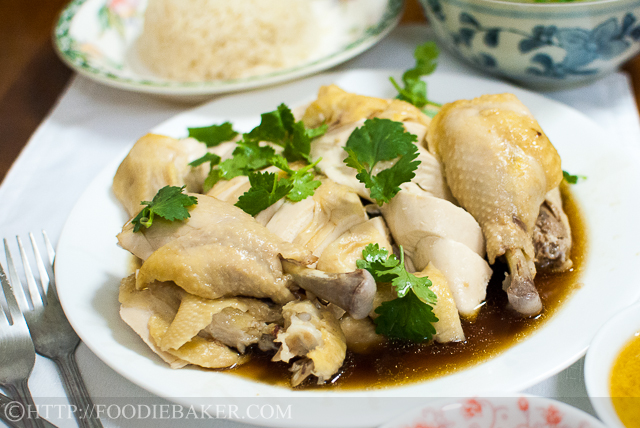
Hainanese Chicken Rice is a classic and popular dish loved by many. It consists of silky smooth poached chicken and steamed seasoned rice. The rice dish is served with chili sauce, ginger sauce and/or thick dark soy sauce on the side.
My Love for Chicken Rice
I grew up eating a lot of poached chicken. My maternal grandparents (in Malaysia) reared chickens in their backyard and during every major Chinese festivities, they would slaughter one or two of their chickens for Chinese prayers. Once the chickens were slaughtered, they were scalded in hot water to loosen the feathers. The grandchildren (me included) would then usually help out by plucking off the chicken feathers. The chicken was poached whole and my grandfather would be in-charged of chopping up the chicken after it had cooled down. I fondly remembered the dogs that my grandparents kept would be on “standby” and waiting besides my grandfather, preying on that stray piece of meat or bone that might fall off the chopping board. My grandmother would always give me the chicken drumstick (I was the favoured grandchildren =p)
After living in Singapore for so many years, I find myself becoming more particular about my chicken rice: the taste and texture of the chicken, the fragrance and flavour of the rice, and even the chili is an important component that cannot be neglected.
This Hainanese chicken rice recipe is originally adapted from 3 websites – Rasa Malaysia, Steamy Kitchen and Adam Liaw – but over the years I have tweaked and made modifications to suit my tastes. I don’t cook it often as it’s too convenient to just buy one packet of chicken rice in Singapore, but I still like to make and serve this as one of the dishes during Chinese New Year, just like how my grandparents used to do in the past.
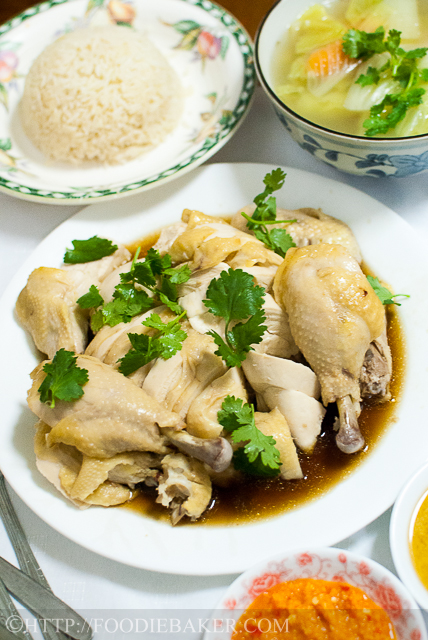
Type of Chicken
There are generally two types of chickens available in Singapore: broiler chicken and kampong chicken. I personally prefer kampung chicken because the meat is leaner and firmer. The skin is also seemingly firmer and has a slight yellowish tint (most likely from eating corn) which looks more appetising to me. Nothing wrong with using broiler chicken either – it is cheaper and usually larger than kampung chicken so you get more meat per dollar. Purely personal preference and either type of chicken should work well.
The only kind of chicken I will not use is frozen chicken. I will only go for fresh chicken when cooking Hainanese chicken rice.
Notes for the Chicken
Here are a few notes to ensure your poached chicken comes out perfect with a jelly-like skin and soft and tender meat.
Exfoliate the chicken with salt. Scrubbing the chicken with coarse salt really helps to make the skin tender and smoother. Don’t use fine table salt as it’s too fine, you will not get the exfoliation effect.
Gentle poaching and steeping. The chicken is gently poached and then steeped in hot water so that the meat cooks gently and gradually. This prevents the meat from being overcooked, and helps to retain the juices within the chicken.
Ice bath. Dunking the poached chicken in ice water will “shock” the chicken skin, resulting in a more elastic and springy skin. It also stops the meat from continuing to cook when removed from the poaching water.
Chopping the chicken. I’ll be honest – I’m not good at it. But here are some videos that I usually refer to whenever I need to chop up a chicken: Video 1; Video 2; Video 3; Video 4.
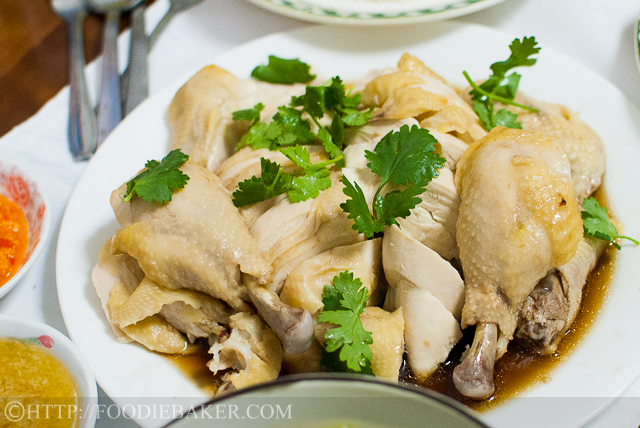
Notes for the Rice
Onion and garlic. I always find the use of onion and garlic a sure guaranteed method to make delicious fragrant rice, not just for Hainanese chicken rice. The use of ginger and pandan is to gravitate the flavour more towards a Hainanese chicken rice, but if you are in a pinch and you don’ have it, feel free to omit them.
Use a rice cooker. It requires lesser chicken stock to cook the same amount of rice.
1/2 rice cooker cup raw rice per person. This is the amount of rice I cook per person. If you are a big eater, do adjust the amount of rice as required.
Notes for the Soup
After poaching the chicken, the stock can be used to make a simple soup to go with the chicken rice.
Add back the chicken feet and chicken head/neck. There are flavour and gelatin in the chicken feet, head/neck which have not been fully extracted during cooking. And since they are parts that no one will eat, I will always add them back to the soup to continue cooking.
Notes for the Chili
Calamansi is different from key lime. These two limes are not the same. Calamansi are smaller and softer than key limes. Make sure you are using the smaller calamansi. It is a pain to zest them but they add a huge fragrance to the chili sauce.
Big chili is different from bird’s eye chili. Bird’s eye chili is a lot spicier than the normal big chili. I don’t like a chili sauce that is too overly spicy as it will overpower the original taste of the food, and I personally also don’t take spicy food very well. This recipe uses only 2 bird’s eye chili but if you love spicy food, feel free to add more.
Great steamboat chili. This chili sauce is also great for steamboat. I like to stir in fresh coriander leaves and sesame seeds to use as a dipping sauce for meats.
Conclusion
Hainanese chicken rice is one of my favourite foods as not only is it delicious, it also brings back fond memories of the time I had with my grandparents (the poached chicken part haha). If cooking a whole chicken feels intimidating, you can try my One-Pot Rice Cooker Hainanese Chicken Rice recipe. It’s also delicious but much easier, and perfect for a weekday night. But still, I hope you could give this Hainanese chicken rice recipe a try one day!
Step-by-Step Photos - Chicken | |
|---|---|
 |  |
| 1) Use a pair of tweezers to pluck out any stuck feather bits. | 2) Rub coarse sea salt all over the chicken, including the cavity. |
 | 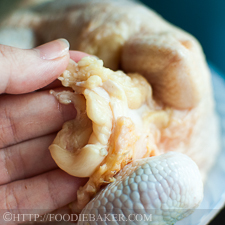 |
| 3) Rinse the salt off the chicken thoroughly. | 4) Trim off excess chicken fats. Reserve the fats to render oil for cooking the rice later on. |
 |  |
| 5) Trim off the ends of spring onions. | 6) Thickly slice a thumb of unpeeled ginger. |
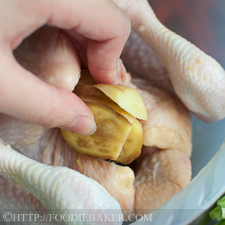 |  |
| 7) Stuff the ginger into the chicken's cavity. | 8) Followed by spring onion. |
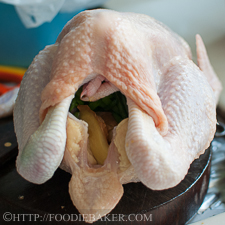 |  |
| 9) Tuck in the chicken feet to pevent the aromatics from falling out. | 10) Place chicken in the pot, add water and bring it to a simmer. Cover and simmer for 20 minutes, then turn off the heat and steep for another 30 minutes. |
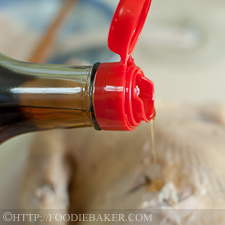 | 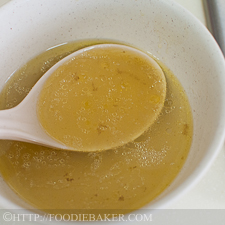 |
| 11) Cool the chicken in an ice wate bath. Drain and rub all over with sesame oil. | 12) Skim off the fat from the pot of water and reserve some water for cooking the rice. Add vegetables and cook to make a pot of soup. |
 |  |
| 13) When ready to serve, chop up the chicken into pieces. | 14) Drizzle with a finishing sauce, garnish and serve. |
Step-by-Step Photos - Rice and Chili | |
|---|---|
 |  |
| 1) Render fat using the trimmed off chicken fat. Add in chopped onion and garlic, and minced ginger and cook until fragrant. | 2) Add in rice until rice is coated with oil. |
 |  |
| 3) Transfer rice into a rice cooker and add in seasonings and chicken stock. Cook accordingly to rice cooker instructions. | 4) Pound chili ingredients together (or use an immersion blender). |
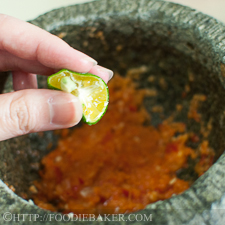 |  |
| 5) Squeeze in lime juice. | 6) Add seasoning to taste. Add in a little chicken stock if desired |
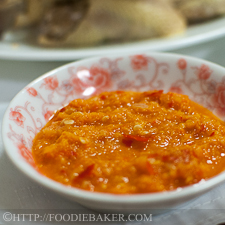 | |
| 7) Serve chili with chicken rice. |

Hainanese Chicken Rice (海南鸡饭)
INGREDIENTS
Chicken
- 1-1.5 kg whole chicken, I personally prefer kampung chicken
- Coarse sea salt, for exfoliating chicken
- 2 inches ginger, unpeeled and sliced thickly
- 3 stalks spring onions, rinsed and roots trimmed off
- ½ tablespoon sea salt
- 2 tablespoons sesame oil
Soup
- 300-400 grams napa cabbage, rinsed and chopped
- 1 large carrot, peeled and cut into chunks
- 1 can whole mushrooms (425g-can)
- Salt and ground white pepper, to taste
Rice
- Chicken fat
- 1 large red onion, peeled and minced
- 4 cloves garlic, peeled and minced
- 1 inch ginger, peeled and grated
- 2 rice cooker cups long grain rice, rinsed and drained
- ¼ teaspoon salt
- ½ tablespoon light soy sauce
- ½ tablespoon sesame oil
- 2 pandan leaves, rinsed and tied into a knot
- 2 rice cooker cups chicken stock, reserved from cooking the chicken
Chilli Sauce
- 100 grams big red chilli, 100 grams ≈ 5 pieces
- 2 bird's eye chili, for spiciness
- 2 garlic, peeled
- ½ inch ginger, peeled
- 1-2 teaspoon sugar
- ¾ teaspoon salt
- 8 calamansi, zested and juiced
- 1 teaspoon sesame oil
Finishing Sauce
- 1 tablespoon sesame oil
- 1 tablespoon light soy sauce
- 4 tablespoons chicken stock, reserved from cooking the chicken
Serving
- 1 bunch fresh coriander leaves, chopped
- 1-2 cucumber , sliced
- Thick dark soy sauce
INSTRUCTIONS
Chicken
- Use a pair of tweezers to pull out any excess feather bits. Rub coarse salt generously all over the chicken, including the cavity, scrubbing the chicken skin well to "exfoliate" the chicken. Rinse the salt thoroughly off the chicken.1-1.5 kg whole chicken, Coarse sea salt
- Trim off the excess chicken fat and reserve the fats. Stuff the ginger and spring onion inside the cavity of the chicken. Twist the chicken feet and stuff them into the cavity.2 inches ginger, 3 stalks spring onions
- Place the chicken in a pot such that it is a snug fit. Fill the pot with enough water to cover the chicken and add in salt.½ tablespoon sea salt
- Cover and set it over high heat and bring the water to a simmer. Immediately turn the heat down to maintain a gentle simmer, and poach the chicken for 20 minutes (the pot is covered). Turn off the heat and let the chicken steep, covered, for another 30 minutes.
- Prepare a large bowl of ice water (big enough to hold the chicken). Lift out the chicken carefully (I find it easier to use 2 chopsticks, poke the chicken from underneath the wings and lift it up) and place it in the bowl of ice water. Gently scoop the ice water over the chicken to cool it and to tighten the chicken skin.
- Once the chicken is cool enough to touch, about 15 minutes, remove the chicken from the ice water and rub sesame oil all over the chicken skin. Set aside to cool completely before chopping the chicken into pieces.2 tablespoons sesame oil
- Reserve stock for rice : Skim off the oil from the soup's surface into a measuring cup. Top up with enough chicken stock to cook the rice.
Soup
- Add in napa cabbage, carrot and canned mushrooms. Simmer until cabbage and carrot are soft. Season to taste with salt and ground white pepper.300-400 grams napa cabbage, 1 large carrot, 1 can whole mushrooms (425g-can), Salt and ground white pepper
Rice
- Cut the trimmed chicken fat into small pieces and place it in a pot. Cook over low heat until the fat has been rendered and the pieces of fat turn crispy. Discard the crispy fats. There should be about 3 tablespoons of oil, otherwise top up with other oil like canola or vegetable.Chicken fat
- Add onion, garlic, and ginger into the chicken oil. Cook gently over low heat, stirring frequently, until mixture is fragrant. Add in the rice and stir to coat the rice with the oil.1 large red onion, 4 cloves garlic, 1 inch ginger, 2 rice cooker cups long grain rice
- Turn off the heat and transfer rice to a rice cooker pot. Stir in salt, soy sauce, sesame oil, pandan leaves and chicken stock. Cook according to rice cooker's instructions.¼ teaspoon salt, ½ tablespoon light soy sauce, ½ tablespoon sesame oil, 2 pandan leaves, 2 rice cooker cups chicken stock
- Note for stovetop cooking: If cooking the rice on the stove top, you will require more chicken stock. The ratio of chicken stock required will be 1.5 to 2 cups of stock per 1 cup of rice.
Chilli Sauce
- Using a pestle and mortar for best results, pound the chilli, garlic, ginger, sugar, salt and calamansi zest together into a paste. Stir in calamansi juice.100 grams big red chilli, 2 bird's eye chili, 2 garlic, 1-2 teaspoon sugar, ¾ teaspoon salt, 8 calamansi, ½ inch ginger
- Stir in the sesame oil just before serving.1 teaspoon sesame oil
- Alternative: Use an immersion blender to blend everything except sesame oil together.
- Note on spiciness: This chili sauce is relatively mild in spiciness. Feel free to use more bird's eye chili as desired. This chili sauce is also great for steamboat.
Finishing
- Combine the sesame oil, soy sauce and chicken broth together in a small bowl. Drizzle sauce over the chopped chicken just before serving.1 tablespoon sesame oil, 1 tablespoon light soy sauce, 4 tablespoons chicken stock
- Garnish the chicken with plenty of coriander leaves and cucumber slices. Serve with rice, soup, chili and thick dark soy sauce.1 bunch fresh coriander leaves, 1-2 cucumber, Thick dark soy sauce
NOTES
Update 28/8/2016: Recipe updated to include 1/2 large red onion in the rice. You can blend the onion, garlic and ginger in a food processor into a paste before cooking it, you won’t taste any bits in the rice, but the flavour these 3 gave to the rice is irresistible!
Update 19/12/2022: Updated post to include tips and notes on making Hainanese chicken rice. Updated recipe to include my new favourite chicken rice chili recipe. Still trying to update the photos with newer ones!

Liebster Award… Thank You! | Food Is My Life says
[…] I love how the silky chicken goes really well with the fragrant rice. Tried my hand on cooking the Hainanese version some time back, I can foresee myself making it very […]
sybaritica says
Excellent … My wife had this in Singapore. I have been meaning to cook it for a while now!
kitchen flavours says
And…. Wish you and your family Gong Xi Fa Cai! 🙂
kitchen flavours says
Your chicken rice looks so good! We love chicken rice in my house, I cook it quite often at home. And I love to eat pak cham kai, especially the leftovers is very, very good, stir-fried with lots of ginger and some see yau with a dash of sesame oil and a pinch of sugar! I could eat two plates of rice with just this leftovers! I sometimes buy an extra big chicken just so I could have the leftovers for a “new dish” the next day!
Wish I could join you! And your chilli sauce is just yum!
kellysiew says
That’s a very good looking Hainanese Chicken Rice! Now that I have a partner who doesn’t eat Chicken, it’s really difficult for me to find any opportunity to cook the whole Chicken. BTW I remember that Chicken facial from Steamy Kitchen, hahaha! For someone who doesn’t know how to chop Chicken, yours came out so professional looking!
ChgoJohn says
My Mom, also, served the soup meats alongside the soup, using each to make a kind of salad. This dish sounds delicious and I like the idea of using chicken fat to make the rice. A great way to add flavor to it, Pu the two together and you’ve made quite a meal, Jasline. Congrats on tackling the recipe!
yummychunklet says
I love chicken and rice! This was a favorite growing up.
A_Boleyn says
I’m not too fond of boiled chicken though my mom made something similar quite often serving the meat and broth separately along with vegetables used to flavour the poaching liquid. She then turned the broth into a soup with fresh egg noodles that she made herself. The combination of spices used in your chili sauce makes it sound very flavourful.
I laughed at the picture of your tweezing the feathers from the chicken. When I roasted the Pekin duck for New Year, I used eyebrow tweezers to get out all the pin feathers and quills. It took me about an hour to get it done to my satisfaction but I never took pictures of the process. Maybe next time. 🙂
I quite enjoy butchering poultry, before and after they’re cooked.
Kim @ Tranquil Dreams says
Wow! Looks awesome! I’ve been looking for this recipe ever since I tried it in Hong Kong. Definitely be trying it out.